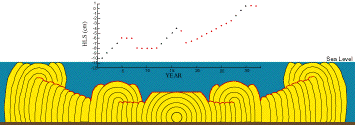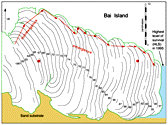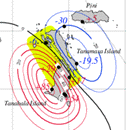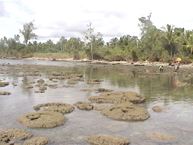 |
 |
 |
| Our early work (Zachariasen et al., 2000) showed that we could recover records of sea level from living coral microatoll colonies by studying their annual growth bands and morphology. We found that many of the offshore islands of Sumatra have been slowly sinking over the past few decades. |  |
| View animations: Coral growth in response to sea level changes. | |
| Our early work also demonstrated
that sudden uplifts of about 1 to 2 meters occurred in association
with a historical great earthquake in 1833 (Zachariasen
et al., 1999). Our modeling of the pattern of
uplift suggested that the 1833 earthquake resulted from slip of
about 12 meters on a large section of the subduction interface
south of the Equator |
|
 |
Near the Equator, the patterns of uplift, submergence and stability have been nearly stable since the early 1960s. Our modeling of these motions (Sieh et al., 1999) suggested that the shallow section of the subduction interface near the Equator has been locked or nearly locked for the past few decades. |
More thorough
investigation of modern and fossil microatolls near the Equator
(Natawidjaja,
2003; Natawidjaja
et al., 2004) revealed a systematic uplift, submergence
and tilt associated with the major earthquake of 1935. Our
modeling of these deformations, in concert with modeling of historical
seismograms (Rivera
et al., 2002) showed that the earthquake was produced
by slip of about 2.5 meters on a 35 by 70-km patch of the subduction
interface. |
 |

